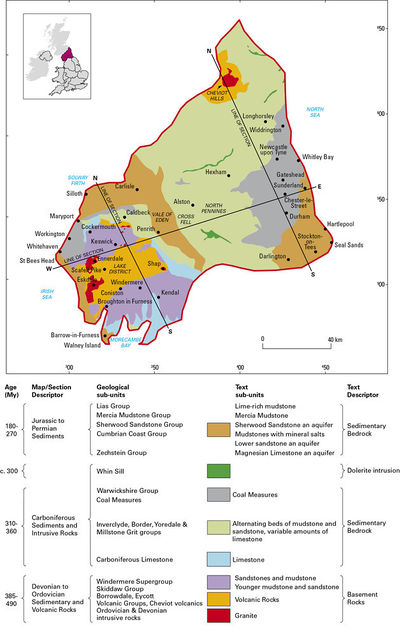Category:7. Northern England district

This account provides a broad perspective of the geology of the Northern England region which extends from the Scottish border southwards to Morecambe Bay in the west and Teesside in the east, covering England’s four northernmost counties of Cumbria, Durham, Tyne & Wear and Northumberland, and also extending into some northern parts of Cleveland, Yorkshire and Lancashire. Figure P902262 provides a geological sketch map of this region showing the rock types occurring in relation to the major towns and cities. This account outlines the geology to a depth of at least a kilometre and summarises the current and historical use of the geological resources in the area.
Within the region a striking diversity of rocks and geological structures are present resulting from a geological history that spans almost 500 million years. The outstanding scenery of this landscape is recognised in the large areas covered by the Lake District and Northumberland National Parks and Areas of Outstanding Natural Beauty which include the Northumberland Coast, the Solway Coast, and the North Pennines.
The geology of the region is well known at and near the surface from natural exposures of rocks along rivers, crags and coastal cliffs, together with observations in quarries and opencast pits and mine workings. Shallow boreholes are also plentiful, commonly drilled for road and other construction work. Below about 50 m most information comes from boreholes drilled for water, coal or for minerals but these are mainly confined to areas where economic resources have been exploited. There are relatively few boreholes deeper than 250 m, though one is the deepest onshore borehole in the UK which was drilled to a depth of 4170 m at Seal Sands on Teesside. Other geological information relating to the deep subsurface has been interpreted from geophysical seismic surveys that provide an understanding of the deep geological structure of the region by sending sound waves through the ground. This is particularly important for interpretation of the geology in the Solway Lowlands and eastwards into Northumberland. Other geophysical surveys, carried out on land or by low flying aircraft, reveal patterns of the Earth’s gravity and magnetic field and have been used to detect and infer the deep geological structure beneath the Lake District, the North Pennines and The Cheviot.
Subcategories
This category has the following 2 subcategories, out of 2 total.
The number of included categories (C), pages (P) and files (F) is stated in brackets.
- Northern England (71 P)